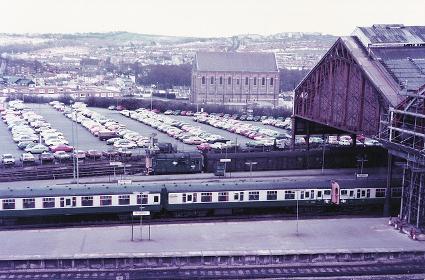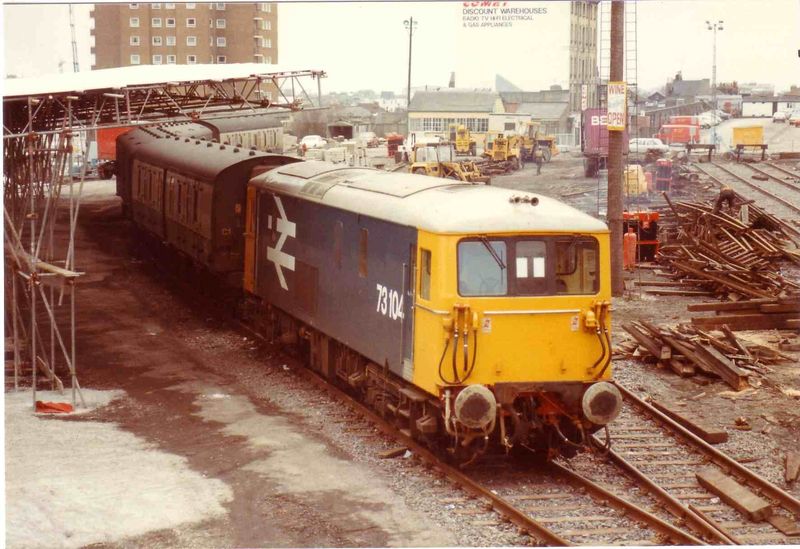CHAPTER 5:
DECLINE

ABOVE: Doctor Richard Beeching, the gentleman seen as the biggest threat to the UK's Rail network in the late 1960's. Whilst not directly responsible for the cuts to a massive 2000 miles of the rail network, it was Dr. Beeching's recommendations that brought about a massive restructure and as a result, many rural lines and engineering centres such as Brighton Locomotive Works were lost due to "rationalisation".
He was appointed to the post of Chairman of the British Railways Board on 15th March 1961. There was widespread concern at the time that, despite substantial investment in the 1955 Modernisation Plan, the railways continued to haemorrhage losses - from £15.6m in 1956 to £42m in 1960. Passenger and goods traffic was also declining in the face of increased competition from the roads as by 1960, one in nine families owned a car. It would be Beeching's task to find a way to returning the industry to profitability as soon as possible.
On 27 March 1963, Beeching published his report on the future of the railways. Entitled "The Reshaping of British Railways", he called for the closure of one-third of the country's 7,000 railway stations. Passenger services would be withdrawn from around 5,000 route miles accounting for an annual train mileage of 68 million and yielding a net saving of £18m per year. The reshaping would also involve the loss of 70,000 British Railways jobs over three years. Beeching forecast that his changes would result in an improvement in British Railway's accounts of between £115m and £147m. The cut-backs would include the scrapping of a third of a million goods wagons.
On 16 February 1965, Beeching further announced the second stage of his reorganisation. The report concluded that of the 7,500 miles of trunk railway throughout Britain, only 3,000 miles "should be selected for future development". This policy would result in traffic through Britain being routed through nine selected lines. Traffic to Coventry, Birmingham,Manchester, Liverpool and Scotland would be routed through the West Coast Main Line running to Carlisle and Glasgow; traffic to the north-east would be concentrated through the East Coast Main Line which was to be closed north of Newcastle; and traffic to Wales and the West Country would go on the Great Western Main Line, then to Swansea and Plymouth. Underpinning Beeching's proposals was his belief that there was still too much duplication (alternative routes to the same location) in the railway network. The second stage of his proposals were rejected by the government in June 1965. It is a matter of debate whether Beeching left by mutual arrangement with the government or if he was sacked.
Unsurprisingly, his plans were hugely controversial not only with trade unions, but with Labour opposition and railway-using public. Beeching was undeterred and argued that too many lines were running at a loss and that his charge to shape a profitable railway made cuts a logical starting point. As one author puts it, Beeching "was expected to produce quick solutions to problems that were deep-seated and not susceptible to purely intellectual analysis."
For his part, Beeching was unrepentant about his role in the closures: "I suppose I'll always be looked upon as the axe man, but it was surgery, not mad chopping." There is speculation that he suffered a great deal of anxiety and ill health through the duration of his life, caused not least by the decisions that he was tasked with making.
But does Dr Beeching really deserve his reputation as the bogeyman of the railways? Arguably not, it seems. Beeching has become a handy scapegoat for our frustration at the failings of the transport system and the destruction of 'traditional' branch line England by modern car culture, but the real instigators of rail closures were civil servants trying to work out how you adapt a country that was built around the horse and cart and steam train, to accommodate the cars people wanted to drive and the lorries business wanted to use.
Doctor Beeching was born in Sheerness, London in April 1913 and died in April 1985.
Mr. L. B. Billinton, the son of Mr. R. J. Billinton.
At this stage, The Works were producing “big engines”; namely the4-6-4T’s for which The Works are famed. As has already been mentioned, the site had buildings of suitably sufficient size to accommodate the construction of such engines. Most of these engines were built just before the LBSCR merged with the Southern Railway under Grouping. Also around this period, The Works contributed to the war effort during World War 1: the site was consigned to the production of munitions, alongside other wartime engineering requirements.
Almost as a culmination of these factors; the war, Grouping and the 4-6-4T’s, the last locomotive designed and built solely at Brighton Works was 4-6-4T no.333, Remembrance, dedicated as the company’s war memorial loco. Remembrance was completed in April 1922. By this time, Mr. Billinton (junior) was responsible for a fleet of some 610 locomotives.
.jpg?timestamp=1376485824850)

ABOVE: 4-6-4 Class L1 No.333, "Remebrance", the Loco Works' war memorial locomotive, also the last loco to be designed and built solely at Brighton Works. The top photo is owned by Mr. C.J.Allen and appears in his book "Steel Highway", 1928. The lower (smaller) photo is owned by Mr. Paul Edwards and appears on the fantastic Brighton Motive Power Depots website.
Apart from Remembrance, locomotives designed by outside engineers were also built at The Works. In the early stages of Grouping, The Works played host to the production of some of Mr. R. E. L. Maunsell’s designs. Ten ‘River’ class 2-6-4 tank locos were built in 1926, followed in 1928 by 10 ‘U’ class 2-6-0’s then 8 of the powerful ‘Z’ class 0-8-0 tanks in 1929.

ABOVE: Z class 0-8-0-Tank locomotive. Image owned by UK Rail.
Sadly, from 1929 onwards, most of the work which had been done at Brighton was subsequently distributed between Ashford and Eastleigh, along with most of The Works’ fabulous array of machinery (although Brighton Works continued to carry out running repairs on locos and rolling stock, eventually including electric stock).
Brighton Works experienced a little glimmer of hope on the horizon in 1942, ironically with more work for the war effort, this time for World War 2. The Works were entirely re-equipped and were commissioned to build some of Bulleid’s light Pacific locos and in all, 104 locomotives were built at the site. In 1945, The Works produced its 1000th engine, light Pacific no.34064, Battle of Britain class "Fighter Command".

ABOVE: In 1945, The Works produced its 1000th engine, light Pacific no.34064, Battle of Britain Class "Fighter Command". The origin of this photo is not known, but I do not claim ownership.
During The Works’ Centenary year (1952),
the site covered 9 acres and employed a staff of 650. At this time, 2 bays of
the main building were used for The Boiler Shop and a 400Hz high frequency
electrical supply was provided to drive high-speed machines used in drilling
and tapping fireboxes. The Works had built up an impressive range of machinery
following the speedy re-equipping for the construction of the light Pacifics in
1942. The Boiler shop had 5 massive cranes: 3 30 ton electric cranes and 2 20
ton capacity, arranged so that each of the 2 bays of the Boiler Shop had both a
20 & 30 tonner at their disposal.
The remaining massive 30-ton crane was
situated spanning the southern end of both bays. This monster was used to lift
boilers for riveting. The Boiler Shop also contained a 90-ton riveting machine
along with its own self-contained hydraulic system. Other equipment included
plate-levelling rolls, a plate edge planer, a pitch fired 250 ton flanging
press and a large array of radial drills.
The Erecting shop covered a further 2 bays of the main building. Locomotive repairs were concentrated in the West Bay at this time. 3 overhead travelling cranes served this Bay: 40 tons, 35 tons and 25 tons respective capacity. The East Bay was largely devoted to building new locomotives and was served by 2 35-ton overhead travelling cranes. Again, this shop contained all manner of equipment, including lathes, drills, grinders and milling machines (the majority of which were individually driven by their own motors).
There were also shops for fitting, copperwork and piping, along with a small brass foundry. There was also a compressor plant with 3 compressors capable of delivering a combined pressure of up to 1200 cu ft/min. There was also an hydraulic plant on the site, delivering 1500 lb/sq inch.
Following Nationalisation, The Works designed
some locomotives to BR Standard specifications; these were to include the 9F
class
.jpg?timestamp=1376488263218)
ABOVE: 80154 was the last new locomotive to be produced on the site. Photo owned by mybrightonandhove.org.uk
After the emergence of 80154 the run-down began in earnest. The Works continued merely to ‘tick over’ handling loco repair work and was also used for building and assembling cars, but this was relatively short-lived by way of a reprieve. Demolition and clearance of the site began in 1969 and the entire site was lost under a huge, bland and totally unremarkable car park in 1971(as was the fate of most goods yards and railway outbuildings in the UK. Otherwise they were destined to become industrial estates. Kemp Town is a prime example) under the overall facelift of Project New Look.




ABOVE: 5 views of Brighton Station's Car Park: (top left to bottom right):1870, 1959, 1983, 2011 and 1996.
For a period after the demolition of the bulk of The Works Buildings, the 1932 signal box was left perched on one corner of the site at the northern end. As has been already mentioned, the signal box was removed towards the end of Project New Look. This was to prove difficult to demolish due to its proximity to the main line tracks and a fire in the box shortly before demolition only served to complicate matters. At the same time, the New England Road Bridge was completely reconstructed (Project New Look) and all the points on the main lines were replaced by large radius turnouts to provide a smoother ride on the approach to the station. It is worth noting that with the removal of Brighton Station’s last signal box, all of the point control was made from a huge control centre at Three Bridges.

ABOVE: Brighton's 1932 Signal Box was left perched on one corner of the site at the northern end, when the rest of the Locomotive Works was demolished and replaced by a huge and totally unimpressive car park. Photo owned by Mr. Adrian Nicholls.

ABOVE: The 1932 Signal Box looking roughly south-east on 19th January 1980. This photo is owned by Mr. John Turner / Models of Hull and appears on the superb wbsframe website.
The Lower Goods Yard was to remain open for about 20 years after the closure of The Works and was finally shut down in October 1980. The site was reopened temporarily for mail traffic during the track alterations at the approach to the station. Aside from diversions to mail trains, most other services were diverted into Hove station during reconstruction, where they were reversed into Brighton on the ‘up tracks’. Services arriving from the east of Brighton were severely disrupted at this stage, as most of them were terminated at Falmer during evenings and weekends, a long way outside Brighton!


ABOVE: The Lower Goods site was reopened temporarily for mail traffic during the track alterations at the approach to the station as part of Operation Newlook.

